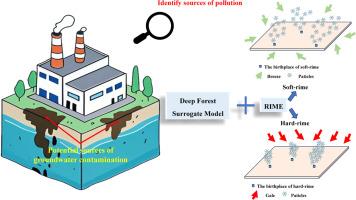基于深度森林代理模型和Rime优化算法的地下水污染源识别框架
IF 4.2
2区 环境科学与生态学
Q1 WATER RESOURCES
引用次数: 0
摘要
当经营企业发生地下水污染时,往往难以及时确定污染源。此外,地下水中污染物的复杂迁移转化,加上监测数据潜在的稀疏性和噪声,导致监测数据具有高度非线性特征,降低了污染源识别的准确性。为了提高GCSI的效率和准确性,我们提出了一种将Deep Forest代理模型与RIME相结合的集成框架,为运营企业的精确GCSI构建了一个高精度、低成本的仿真优化系统。我们利用实际案例数据建立了高精度的地下水数值模拟模型,并将其用于生成GCSI所需的数据集。本研究的目的是建立一个包括深度森林代理模型和RIME在内的框架,并通过与反向传播神经网络(BPNN)、双向长短期神经网络(BiLSTM)和遗传算法(GA)的比较来评估其效率和准确性。结果表明,Deep Forest的准确率略高于BiLSTM, RMSE值为70.4469,MAE值为37.1714,R2值为0.9793。BPNN所需的时间最少,为17.4103 s,但精度最差。值得注意的是,与BiLSTM相比,Deep Forest减少了9.8%的计算时间。当将Deep Forest识别的污染源结果输入地下水数值模型时,模拟污染物浓度与观测污染物浓度的相对误差≤15%。本文章由计算机程序翻译,如有差异,请以英文原文为准。

A hybrid Deep Forest surrogate model and Rime optimization algorithm (RIME) framework for groundwater contamination source identification (GCSI)
When groundwater pollution occurs in operating-enterprises, it is often difficult to determine the source of pollution in a timely manner. In addition, the complex migration and transformation of pollutants in groundwater, coupled with the potential sparsity and noise of monitoring data, result in highly nonlinear characteristics of monitoring data, which reduces the accuracy of source identification. In order to improve the efficiency and accuracy of GCSI, we propose an integrated framework that combines Deep Forest surrogate model with the RIME, creating a high-accuracy, low-cost simulation-optimization system for precise GCSI in operating-enterprises. We establishes a high-precision groundwater numerical simulation model using practical case data, which was then used to generate the dataset required for GCSI. The objective of this work is to establish a framework, including Deep Forest surrogate model and RIME, and evaluate the efficiency and accuracy through comparing with Backpropagation Neural Networks (BPNN), Bidirectional Long Short-term neural networks (BiLSTM), and Genetic Algorithm (GA). The results indicate that the accuracy of the Deep Forest is slightly higher than that of BiLSTM, with RMSE value of 70.4469, MAE value of 37.1714, and R2 value of 0.9793. BPNN requires the least amount of time, at 17.4103 s, but has the worst accuracy. It is worth noting that compared to BiLSTM, Deep Forest reduces computation time by 9.8 %. When inputting Deep Forest identified contamination source results into the groundwater numerical model, the relative error between simulated and observed contaminant concentrations is ≤15 %.
求助全文
通过发布文献求助,成功后即可免费获取论文全文。
去求助
来源期刊

Advances in Water Resources
环境科学-水资源
CiteScore
9.40
自引率
6.40%
发文量
171
审稿时长
36 days
期刊介绍:
Advances in Water Resources provides a forum for the presentation of fundamental scientific advances in the understanding of water resources systems. The scope of Advances in Water Resources includes any combination of theoretical, computational, and experimental approaches used to advance fundamental understanding of surface or subsurface water resources systems or the interaction of these systems with the atmosphere, geosphere, biosphere, and human societies. Manuscripts involving case studies that do not attempt to reach broader conclusions, research on engineering design, applied hydraulics, or water quality and treatment, as well as applications of existing knowledge that do not advance fundamental understanding of hydrological processes, are not appropriate for Advances in Water Resources.
Examples of appropriate topical areas that will be considered include the following:
• Surface and subsurface hydrology
• Hydrometeorology
• Environmental fluid dynamics
• Ecohydrology and ecohydrodynamics
• Multiphase transport phenomena in porous media
• Fluid flow and species transport and reaction processes
 求助内容:
求助内容: 应助结果提醒方式:
应助结果提醒方式:


